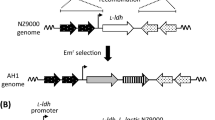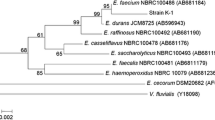Abstract
To achieve direct and efficient lactic acid production from starch, a genetically modified Lactococcus lactis IL 1403 secreting α-amylase, which was obtained from Streptococcus bovis 148, was constructed. Using this strain, the fermentation of soluble starch was achieved, although its rate was far from efficient (0.09 g l−1 h−1 lactate). High-performance liquid chromatography revealed that maltose accumulated during fermentation, and this was thought to lead to inefficient fermentation. To accelerate maltose consumption, starch fermentation was examined using L. lactis cells adapted to maltose instead of glucose. This led to a decrease in the amount of maltose accumulation in the culture, and, as a result, a more rapid fermentation was accomplished (1.31 g l−1 h−1 lactate). Maximum volumetric lactate productivity was further increased (1.57 g l−1 h−1 lactate) using cells adapted to starch, and a high yield of lactate (0.89 g of lactate per gram of consumed sugar) of high optical purity (99.2% of l-lactate) was achieved. In this study, we propose a new approach to lactate production by α-amylase-secreting L. lactis that allows efficient fermentation from starch using cells adapted to maltose or starch before fermentation.





Similar content being viewed by others
References
Andersson U, Rådström P (2002) Physiological function of the maltose operon regulator, MalR, in Lactococcus lactis. BMC Microbiol 2:28
Bolotin A, Wincker P, Mauger S, Jaillon O, Malarme K, Weissenbach J, Ehrlich SD, Sorokin A (2001) The complete genome sequence of the lactic acid bacterium Lactococcus lactis ssp. lactis IL 1403. Genome Res 11:731–753
Christiaens H, Leer RJ, Pouwels PH, Verstraete W (1992) Cloning and expression of a conjugated bile acid hydrolase gene from Lactobacillus plantarum by using a direct plate assay. Appl Environ Microbiol 58:3792–3798
Dubois M, Gilles KA, Hamilton JK, Rebers PA, Smith F (1956) Colorimetric method for determination of sugars and related substances. Anal Chem 28:350–356
Fukushima K, Sogo K, Miura S, Kimura Y (2004) Production of d-lactic acid by bacterial fermentation of rice starch. Macromol Biosci 4:1021–1027
Giraud E, Champailler A, Raimbault M (1994) Degradation of raw starch by a wild amylolytic strain of Lactobacillus plantarum. Appl Environ Microbiol 60:4319–4323
Guyot JP, Calderon M, Morlon-Guyot J (2000) Effect of pH control on lactic acid fermentation of starch by Lactobacillus manihotivorans LMG 18010T. J Appl Microbiol 88:176–182
Hofvendahl K, Hahn-Hägerdal B (1997) l-Lactic acid production from whole wheat flour hydrolysate using strains of Lactobacilli and Lactococci. Enzyme Microb Technol 20:301–307
Hofvendahl K, Hahn-Hägerdal B (2000) Factors affecting the fermentative lactic acid production from renewable resources. Enzyme Microb Technol 26:87–107
Holo H, Nes IF (1989) High-frequency transformation, by electroporation, of Lactococcus lactis subsp. cremoris grown with glycine in osmotically stabilized media. Appl Environ Microbiol 55:3119–3123
Law J, Buist G, Haandrikman A, Kok J, Venema G, Leenhouts K (1995) A system to generate chromosomal mutations in Lactococcus lactis which allows fast analysis of targeted genes. J Bacteriol 177:7011–7018
Linko YY, Javanainen P (1996) Simultaneous liquefaction, saccharification, and lactic acid fermentation on barley starch. Enzyme Microb Technol 19:118–123
Narita J, Nakahara S, Fukuda H, Kondo A (2004) Efficient production of l-(+)-lactic acid from raw starch by Streptococcus bovis 148. J Biosci Bioeng 97:423–425
Narita J, Ishida S, Okano K, Kimura S, Fukuda H, Kondo A (2006a) Improvement of protein production in lactic acid bacteria using 5′-untranslated leader sequence of slpA from Lactobacillus acidophilus. Appl Microbiol Biotechnol 73:366–373
Narita J, Okano K, Kitao T, Ishida S, Sewaki T, Sung MH, Fukuda H, Kondo A (2006b) Display of α-amylase on the surface of Lactobacillus casei cells by use of the PgsA anchor protein, and production of lactic acid from starch. Appl Environ Microbiol 72:269–275
Naveena BJ, Altaf M, Bhadriah K, Reddy G (2005) Selection of medium components by Plackett–Burman design for production of L(+) lactic acid by Lactobacillus amylophilus GV6 in SSF using wheat bran. Bioresour Technol 96:485–490
Nilsson U, Rådström P (2001) Genetic localization and regulation of the maltose phosphorylase gene, malP, in Lactococcus lactis. Microbiology 147:1565–1573
Qian NY, Stanley GA, Hahn-Hägerdal B, Rådström P (1994) Purification and characterization of two phosphoglucomutases from Lactococcus lactis subsp. lactis and their regulation in maltose- and glucose-utilizing cells. J Bacteriol 176:5304–5311
Satoh E, Ito Y, Sasaki Y, Sasaki T (1997a) Application of the extracellular α-amylase gene from Streptococcus bovis 148 to construction of a secretion vector for yogurt starter strains. Appl Environ Microbiol 63:4593–4596
Satoh E, Uchimura T, Kudo T, Komagata K (1997b) Purification, characterization, and nucleotide sequence of an intracellular maltotriose-producing α-amylase from Streptococcus bovis 148. Appl Environ Microbiol 63:4941–4944
Santoyo MC, Loiseau G, Sanoja RR, Guyot JP (2003) Study of starch fermentation at low pH by Lactobacillus fermentum Ogi E1 reveals uncoupling between growth and α-amylase production at pH 4.0. Int J Food Microbiol 80:77–87
Zhang DX, Cheryan M (1991) Direct fermentation of starch to lactic acid by Lactobacillus amylovorus. Biotechnol Lett 13:733–738
Acknowledgments
The present study was funded by the 2003 Regional Innovative Consortium Project of the Ministry of Economy, Trade and Industry, Japan. We are grateful to Meiji Dairies Corporation for supplying the pSECE1 plasmid.
Author information
Authors and Affiliations
Corresponding author
Rights and permissions
About this article
Cite this article
Okano, K., Kimura, S., Narita, J. et al. Improvement in lactic acid production from starch using α-amylase-secreting Lactococcus lactis cells adapted to maltose or starch. Appl Microbiol Biotechnol 75, 1007–1013 (2007). https://doi.org/10.1007/s00253-007-0905-0
Received:
Revised:
Accepted:
Published:
Issue Date:
DOI: https://doi.org/10.1007/s00253-007-0905-0




